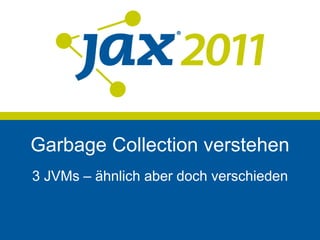
JAX 2011 - Garbage collection verstehen
- 1. Garbage Collection verstehen 3 JVMs – ähnlich aber doch verschieden
- 2. • Langsam? Wann und Warum • Auswirkungen • Jede JVM ist anders • GC Strategien & Richtiges Tuning • Probleme und Lösungen
- 3. Die Basics
- 4. GC auf einen Blick Nicht Erreichbare Objekte Garbage Vergessene Referenz Memory Leak Erreichbare Objekte GC Roots
- 5. Viele (über)lebende Objekte = Lange Garbage Collection
- 6. Generational Heap • Wenige Allokationen • Viele Überlebende • Viele Allokationen • Wenige Überlebende Marking Phase Marking Phase Speicher nach Sweep Nach Copy Phase
- 7. Performance Auswirkungen Runtime Suspensions
- 8. Suspensions • Alle Anwendungs Threads pausieren • Auch Young/Minor Collections! • Antwortzeiten 1:1 • Durchsatz Exponentiell
- 9. Suspensions Serial Collector Parallel Collector Pause Pause Remark Concurrent Mark Concurrent Collector Concurrent Sweep
- 11. Fragmentierung Marking Phase Speicher nach Sweep
- 12. Compacting GC • Young Generation Copy Collection • Old Generation (außer CMS) Fragmentierter Speicher Speicher nach Kompaktifizierung
- 13. Performance Auswirkungen CPU Verbrauch
- 14. CPU Verbrauch • Zeit ≈ CPU Zeit • Seriell <≈ Parallel • Je mehr CPUs desto kürzer Suspension • Negative Auswirkung auf andere Prozesse • CMS single Threaded
- 15. Die Unterschiede Jede JVM ist anders
- 16. Young Tenured Eden Survior Survior SUN/ORACLE JVM
- 17. ORACLE JROCKIT
- 18. Heap • Generational Nursery Tenured Keep Area oder • Kontinuierlicher Heap
- 19. Mostly Concurrent Mark and Sweep Pause Final Remark Concurrent Mark & remark Sweep 1. Hälfte Sweep 2. Hälfte Pause
- 20. Compacting Windows • Inkrementelles Compacting • Auch bei CMS Fragmentierter Speicher
- 21. Thread-Lokale Allokation • Separatere Heap Bereiche • Dynamische Zuteilung • Keine Synchronisation Schnellere Allokation
- 22. „GROßE“ UND „KLEINE“ OBJEKTE
- 23. Permanent Generation? • Klassen werden wie Objekte behandelt • Sofortige Garbage Collection möglich!
- 24. IBM JVM
- 25. Die Unterschiede • Kontinuierlicher Heap ist Standard • Allocate und Survivor • „Große“ und „Kleine“ Objekte • Keine Permanent Generation Nursery Tenured Allocate Survior
- 27. Das Ziel vor Augen halten
- 28. GC Strategien Antwortzeit Durchsatz Kontinuierlicher Heap Kleine Anwendungen, Clients, evtl mit CMS Ja, Parallel GC Generational Heap Ja Ja, parallel GC Concurrent Mark and Sweep Server Nein, außer wenn Suspension sensitiv Parallel GC Young, Nicht old Ja
- 29. Richtig Messen • Suspensions messen Auswirkung auf Antwortzeit • Garbage Collection Zeit/CPU messen • Garbage Collection Häufigkeit messen
- 30. JMX Metriken
- 31. Echte Auswirkung
- 32. Auf die Größe kommt es an • Objekt stirb Young • Old Generation abspecken • Richtiges Verhältnis
- 33. Objekt Churning • Allokiere so viel du willst, aber – nicht zu viel – nicht zu lange • Cachen ist gut, aber – Nicht zu viel – Nicht zu kurz
- 35. Minor vs. Major • Minor Collections pausieren auch! • Old Generation ≠ Major Collection
- 36. Zu großer Heap • Lange und teure Garbage Collections • Caches – HTTP-Session as Cache – Soft/Weak Referenzen • Memory Leaks
- 37. Memory Leaks • Statische veränderliche Variablen • Thread Lokale Variablen • JNI • Equals/Hashcode • Bi-direktionale Referenzen
- 38. Bi-direktionale Referenzen Document doc = readXmlDocument(); Node child = doc.getDocumentElement().getFirstChild(); doc.removeNode(child); doc = null; // child hat eine Referenz auf doc, // daher doc wird nicht freigegeben
- 39. Classloader Probleme • Class Loader Leaks • Mehrfach geladene Klassen • Zu viele, große Klassen • Wiederholtes Laden
- 40. Out Of Memory • GC Thrashing • Transaktionaler Speicherverbrauch • Große temporare Objekte • Permanent Generation
- 41. Große Temp. Objekte byte tmpData[] = new byte [1024]; int offs = 0; do{ int readLen = bis.read (tmpData, offs, tmpData.length - offs); if (readLen == -1) break; offs+= readLen; if (oofs == tmpData.length){ byte newres[] = new byte[tmpData.length + 1024]; System.arraycopy(tmpData, 0, newres, 0, tmpData.length); tmpData = newres; } } while (true);
- 42. FRAGEN Michael Kopp michael.kopp@dynatrace.com @mikopp http://blog.dynatrace.com
Hinweis der Redaktion
- Wie funktioniert GC eigentlich, GC Roots, traverse objects. Nicht erreichbare objekte?
- Das ist eine Krux und wir werden sehen das sich das durchzieht. Einerseits haben werden sehr viele kurzlebige Objekte erzeugt die der Garbage Collector effizient entfernt, andererseits haben heutige Applikationen eine immer groessere anzahl von lang lebigen Objekten.
- Der concurrent wird allerdings fast nur bei einem normallen mark and sweep. Also nicht in der young generation. Wir sehen hier schon das das ganze ein trade off ist. Es werden zwar die unterbrechungen kuerzer, allerdings steigt dadurch der CPU verbrauch. Das ist etwas das man immer bedenken muss, mann kann nur fuer eine seite tunen.
- Allokationen werden langsamer Sweep Phase wird langsamer OutOfMemory bei grossen objekten Vorteil des copy collectors
- Kompletter Heap Parallel CMS gar nicht? Das gilt fuer die Sun JVM wohlgemerkt!
- Objekte im eden angelegt, dann in einen aktiven survivor promoted. Dann so oft hin und her kopiert bis die kriterien erfuellt sind. Das geht nicht immer. Young Gen Garantie! Missing perm generation. haellt
- Kontinuierlicher und Generationaler Heap
- Internal/external
- Response time vs. CPU Verbrauch aka Throughput.
- Das problem mit allokationen ist oftmals nicht einmal der GC selbst, sondern das allokieren an und fuer sich. Und natuerlich wenn ich mehr objekte erzeuge als im young platz haben.
- Caches Soft Referenzen
- Sun jvm oom, wenn zuviel gc
- Ineffizienter Code Major Collections ohne ersichtlichen Grund Out Of Memory mit genügend freiem Speicher
